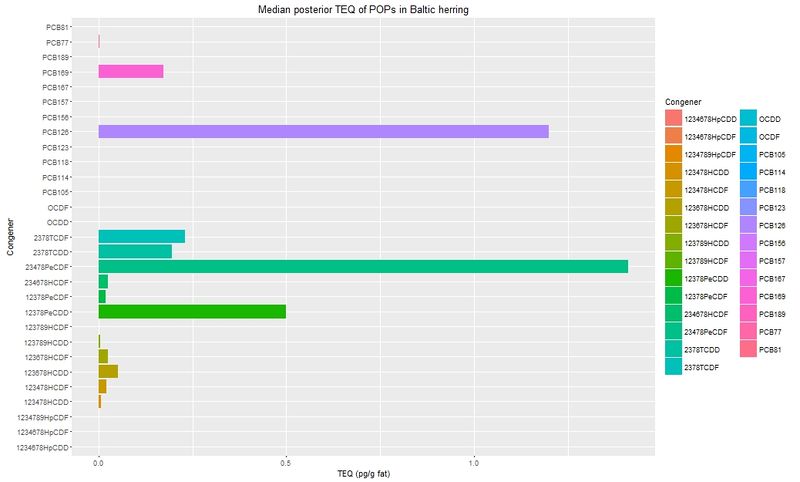POPs in Baltic herring
| Moderator:Nobody (see all) Click here to sign up. |
|
|
| Upload data
|
Contents
Question
What are the concentrations of persistent organic pollutants (POPs) in Baltic herring.
Answer
Answer is under work and results are preliminary.
POP concentrations in Baltic sea fish have been measured from samples collected in EU-kalat project. The original data of individual fish samples is accessible through Opasnet base. This data is used here for a Bayesian model to calculate posterior concentration distributions (median and SD) for each congener. This data is then translated into TEQ, and can be used for health benefit assessment of Baltic herring.
Posterior congener median concentrations are presented below for each compound group (PCDD/F, PCB, BDE) analysed in EU-kalat.
Based on the mean posterior concentrations of individual congeners, TEQs are calculated for each congener by using TEF values by WHO and plotted below.
You can print out the numerical results of prior and posterior congener concentrations below. In addition the possible updated versions of the above figures are printed out.
Rationale
HELCOM has reported [1] that in the south western part of the Baltic and in Danish waters the average dioxin content in herring is 2-2.5 pg WHO-TEQ/g fresh weight. In comparison, levels are approximately double this figure in the Baltic Proper and the Gulf of Finland and four times higher in the Bothnian Sea and the southern part of the Bothnian Bay.
Northern Baltic sea
This model takes in measured congener concentrations of POPs in Baltic herring in northern part of Baltic sea (Bothnian Bay, Bothnian Sea, Åland Sea, Gulf of Finland). Measured data is used for Bayesian model to produce posterior medians and sds for each congener and also to calculate TEQ values. Numerical results are saved as variables to Opasnetbase and result figures are presented above in the Answer section.
Southern Baltic sea
Pandelova et al. [2] have measured PCDD/Fs and PCB concentrations in Baltic herring taking samples from Gulf of Finland, Gulf of Riga and open Baltic sea. Results as TEQs (pg WHO-TEQ/g fw) are presented separately for herrings with different age.
| Obs | Area | Time | Age | Result |
|---|---|---|---|---|
| 1 | Gulf of Riga | 2002 | 2.0–2.5 | 1.08 |
| 2 | Gulf of Riga | 2004 | 2.0–2.5 | 2.14 |
| 3 | Gulf of Riga | 2005 | 2.0–2.5 | 1.75 |
| 4 | Gulf of Riga | 2003 | 3.0–3.5 | 1.5 |
| 5 | Gulf of Riga | 2002 | 3.5–4.0 | 1.72 |
| 6 | Gulf of Riga | 2003 | 3.5–4.0 | 1.44 |
| 7 | Gulf of Finland | 2002 | 1.5–2.0 | 0.63 |
| 8 | Gulf of Finland | 2002 | 2.0–2.5 | 0.75 |
| 9 | Gulf of Finland | 2004 | 2.0–2.5 | 1.07 |
| 10 | Gulf of Finland | 2005 | 2.0–2.5 | 0.98 |
| 11 | Gulf of Finland | 2002 | 2.5–3.0 | 1.08 |
| 12 | Gulf of Finland | 2005 | 2.5–3.0 | 0.98 |
| 13 | Gulf of Finland | 2002 | 4.5–5.0 | 1.43 |
| 14 | Gulf of Finland | 2003 | 4.5–5.0 | 3.07 |
| 15 | Open Baltic Sea | 2004 | 1.5–2.0 | 1.25 |
| 16 | Open Baltic Sea | 2004 | 2.0–2.5 | 1.14 |
| 17 | Open Baltic Sea | 2002 | 3.5–4.0 | 2.18 |
| Obs | Area | Time | Age | Result |
|---|---|---|---|---|
| 1 | Gulf of Riga | 2004 | 1.5–2.0 | 1.31 |
| 2 | Gulf of Riga | 2005 | 2.0–2.5 | 0.83 |
| 3 | Gulf of Riga | 2003 | 3.0–3.5 | 1.34 |
| 4 | Gulf of Riga | 2003 | 3.5–4.0 | 1.47 |
| 5 | Gulf of Finland | 2004 | 2.0–2.5 | 0.67 |
| 6 | Gulf of Finland | 2005 | 2.0–2.5 | 0.68 |
| 7 | Gulf of Finland | 2004 | 2.5–3.0 | 1.03 |
| 8 | Gulf of Finland | 2005 | 2.5–3.0 | 0.72 |
| 9 | Gulf of Finland | 2003 | 4.5–5.0 | 2.48 |
| 10 | Open Baltic Sea | 2004 | 1.5–2.0 | 1.21 |
| 11 | Open Baltic Sea | 2004 | 2.0–2.5 | 1.07 |
| 12 | Open Baltic Sea | 2003 | 4.0–4.5 | 2.09 |




